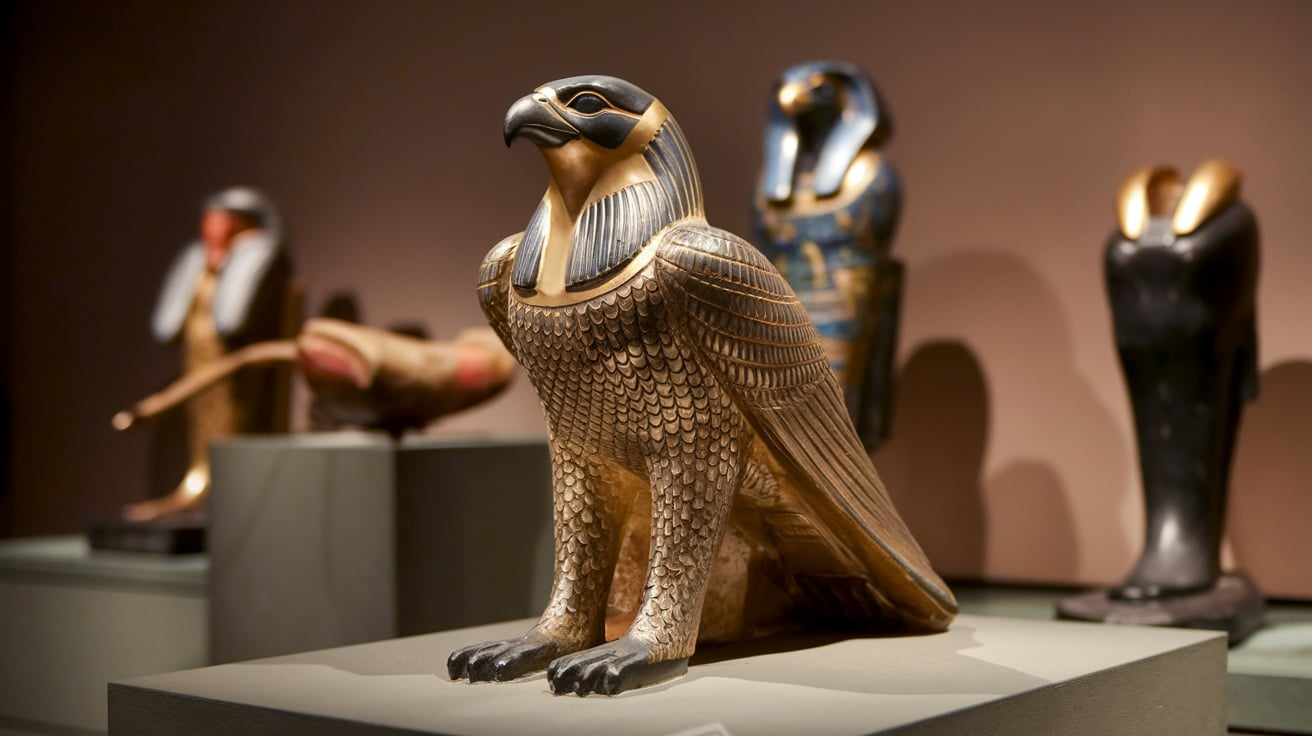Introduction
The figure of Horus as a falcon at LACMA is a remarkable artifact that reflects ancient Egypt’s rich spiritual and artistic traditions. This bronze sculpture, dating to the Ptolemaic-Roman period, represents Horus, the falcon-headed deity revered for his association with kingship, protection, and the sky. As a centerpiece in LACMA’s Egyptian art collection, this piece showcases the precision and symbolism of ancient craftsmanship. The figure of Horus as a falcon at LACMA highlights Horus’s religious significance and provides modern viewers with a tangible link to Egypt’s profound cultural legacy.
Historical Significance of the Figure
The figure of Horus as a falcon at LACMA reflects the historical reverence for Horus in ancient Egypt.Horus, a representation of protection and kingship, was portrayed as a falcon to represent his divine might.This sculpture dates back to the Ptolemaic-Roman period when Egyptian art blended with Greek and Roman influences. The figure of Horus as a falcon at LACMA is a testament to Horus’s spiritual and political role in Egyptian society.
Artistic Representation of Horus
The figure of Horus as a falcon at LACMA is a masterpiece of ancient craftsmanship. Made from bronze, the sculpture highlights the meticulous detailing of the falcon’s form, showcasing the precision of Egyptian artisans. The use of falcons in art symbolized speed and vision, aligning with Horus’s attributes. This piece demonstrates the blend of aesthetics and symbolism that defined Egyptian religious art.
Materials and Craftsmanship
The figure of Horus as a falcon at LACMA was crafted using bronze, a material often associated with durability and prestige. The choice of bronze reflects the high status of Horus in Egyptian culture and the advanced metallurgical skills of the time. The falcon’s smooth texture and intricate design showcase the sophistication of ancient Egyptian artisanship, making it a prized artifact.
Connection to Egyptian Mythology
The figure of Horus as a falcon at LACMA represents the deity Horus, a central figure in Egyptian mythology. As the god of the sky and protector of pharaohs, Horus was often depicted with falcon-like features. This sculpture embodies his divine role, particularly his association with kingship and cosmic order. Its presence at LACMA allows viewers to connect with the mythological roots of Egyptian civilization.
Symbolism of the Falcon
The falcon in the figure of Horus as a falcon at LACMA symbolizes power, protection, and divine vision. In Egyptian culture, falcons were revered for their hunting skills and sharp eyesight, qualities attributed to Horus. This sculpture captures the natural elegance and infants’ spiritual significance in Egyptian belief systems.
The Role of Horus in Ancient Egypt
The figure of Horus as a falcon at LACMA underscores Horus’s role as a protector and unifier of Egypt. Associated with pharaohs, Horus was believed to embody their divine authority. This sculpture highlights the deity’s importance in maintaining cosmic balance and safeguarding the kingdom, making it an essential representation of Egypt’s religious hierarchy.
Cultural Blending in the Ptolemaic-Roman Period
The figure of Horus as a falcon at LACMA originates from the Ptolemaic-Roman period, a time of cultural fusion in Egypt. This era blended traditional Egyptian motifs with Greek and Roman artistic styles. The sculpture reflects this synthesis, preserving the core symbolism of Horus while showcasing stylistic influences of the time.
Preservation and Display at LACMA
The figure of Horus as a falcon at LACMA is carefully preserved to maintain its historical and artistic integrity. The artifact is displayed with context and reverence as part of LACMA’s ancient art collection. Its inclusion in the museum allows for broader public engagement with Egypt’s cultural heritage, offering insights into its artistic and religious traditions.
Educational Value of the Sculpture
The figure of Horus as a falcon at LACMA is an educational tool for understanding ancient Egypt. Through this piece, visitors can explore the role of Horus in mythology, the techniques of ancient metalworking, and the cultural significance of falcons. It provides a tangible connection to Egypt’s past, fostering appreciation and learning.
Legacy of Horus at LACMA
The figure of Horus as a falcon at LACMA ensures the enduring legacy of Horus as a powerful symbol of protection and authority. By showcasing this sculpture, LACMA highlights Egyptian art’s and mythology’s timeless relevance. The artifact continues to inspire admiration for the creativity and spirituality of ancient Egyptian civilization.
Conclusion
The figure of Horus as a falcon at LACMA is a captivating artifact that bridges the past and present, showcasing ancient Egypt’s artistic and cultural depth. This sculpture embodies Horus’s power, protection, and divine essence, serving as both a symbol of Egyptian mythology and a testament to the craftsmanship of the era. Its preservation and display at LACMA allow modern audiences to engage with Egypt’s rich history, ensuring its legacy inspires and educates future generations.
